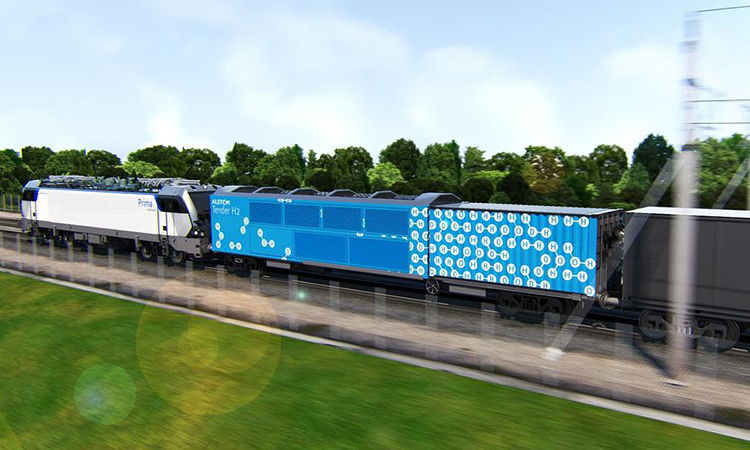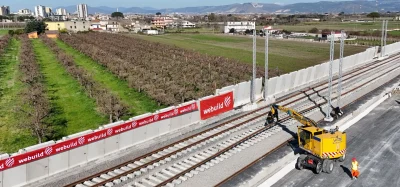Nestlé Waters France to be first company in Europe to use hydrogen powered freight train
Posted: 24 November 2022 | Elliot Robinson (Editorial Assistant - Global Railway Review) | No comments yet
An innovative hydrogen fuel cell system developed by Alstom and ENGIE is to be used by Nestlé Waters France for rail freight transport from 2025.


Credit: Alstom Advanced & Creative Design
Nestlé Waters will be the first company in Europe to benefit from a hydrogen fuel cell solution for massified rail freight, including renewable hydrogen supply, developed by Alstom and ENGIE. It is estimated that this project will reduce emissions by 10,000 tonnes of CO2 equivalent per year, in the long term this will lead to the reduction of 90 per cent of Nestlé Waters current emissions. This is the equivalent to the annual emissions of more than 30,000 round trips from Paris to Nice by car.
Nestlé Waters and the new hydrogen solution
As a significant innovation, the new hydrogen solution will be developed from a high-powered fuel cell system that can power electric locomotives in non-electrified areas. This solution will be able to transport goods over long distances, on a national and European scale.
From 2025, this freight train powered by electricity from the rail network and from hydrogen in non-electrified sectors will aim to progressively ensure the transport of VITTEL® natural mineral water between the factory located in the Vosges and its various distribution centres in France. The dual-mode solution will be composed by a generator wagon incorporating a high-power fuel cell system powered by renewable hydrogen and a line-electric locomotive, all connected by an electrical power cable. The generating wagon will be able to supply the locomotive with electricity in the without the need for any catenary.
“At Nestlé Waters, we favour rail freight whenever possible and we are constantly looking for efficient solutions to reduce the carbon impact of our supply chain,” Sophie Dubois, Chief Executive Officer of Nestlé Waters in France, said. “We are very proud of this project as it represents a significant investment by our railway team to find innovative solutions to answer to climate and environmental challenge. This collaboration with Alstom and ENGIE will accelerate the development of a decarbonised/carbon-free supply chain.”
Related news you will enjoy:
Alstom announce expanded presence in Saudi Arabia
Alstom sign Strategic Cooperation Agreement with the Government of Hungary
Developing the hydrogen solution
The high-power hydrogen fuel cell system developed by Alstom will power electric locomotives in non-electrified areas and offer a 100 per cent electric solution for rail freight, end-to-end, including to the first and last kilometres, which are rarely electrified.
This innovative solution will make it possible to carry out all freight journeys with the same electric locomotive, powered by the catenary on electrified main lines and by the hydrogen generator wagon in non-electrified areas.
In terms of performance, the solution will provide all the power of a catenary-based mainline electric locomotive and enough power with hydrogen energy to pull a freight train over non-electrified line segments. ENGIE will supply the renewable hydrogen for this solution through the deployment of an innovative supply chain.
“Alstom has been a pioneer in hydrogen trains by developing the first hydrogen train in commercial operation worldwide.” Marc Granger, Chief Strategy Officer of Alstom, said. “Our ambition is to accelerate the adoption of hydrogen in the rail industry and to develop innovative solutions for the greening of mass mobility, including rail freight. Therefore, we are looking forward to the first circulation of a freight locomotive powered by renewable hydrogen in 2025. To go further, this solution, which is more environmentally friendly and generates less noise than diesel, will make it possible to develop the modal share of rail freight by offering an end-to-end electric solution, a real alternative to freight transport.”
“Following the announcement of our partnership with Alstom to supply hydrogen to this new European rail decarbonisation solution,” Sébastien Arbola, Executive Vice President in charge of Thermal Generation and Hydrogen & Energy Supply activities for ENGIE, said. “Nestlé Waters becomes the first prime contractors for our offer, and the first future user of our solution. This is a key step in the development of this project. Hydrogen plays an essential role in the transition of industrial companies towards reducing their emissions, a dynamic in which ENGIE is fully involved.”
Related topics
Cargo, Freight & Heavy-Haul, Electric/Hybrid Rolling Stock, Hydrogen Trains, Operational Performance, Sustainability/Decarbonisation







